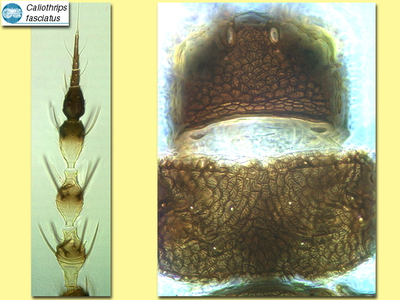Figures
Fig. 1 Antenna, head and pronotum
Fig. 2 Fore and hind wing
Fig. 3 Tergite III and IV, sternites (male)
Species
Caliothrips fasciatus Pergande
Biology
Apparently associated with the leaves of leguminous plants, this species has been reported as a pest of bean crops.
Distribution
Widespread in western North America and south to Mexico, this species has been taken several times in quarantine at Perth, on citrus from California.
Recognition
Small brown thrips with legs and antennae bicoloured brown and yellow; forewings largely dark with basal fifth and subdistal fifth pale. Body with complex sculpture, the reticles on head, pronotum and lateral areas of tergites with complex internal sculptured markings. Sculpture on the lateral thirds of the abdominal tergites consists of equiangular reticles; tergites and sternites all with prominent posteromarginal craspedum.
Related species
About 20 species are known in this genus, from various parts of the tropics. They can be distinguished from each other by details of the wing colour, and of the sculpture on the abdominal tergites (Mound & Gillespie, 1997). Only one species is found commonly in Australia, the grass living species C. striatopterus, although a second grass-living species, C. graminicola, is sometimes found in northern Australia.




